Eonium and its cultivation

Interest in the features of such a flower as aeonium and the rules for its cultivation is explained by the uniqueness and outstanding decorative qualities of this succulent. He came to our region from his homeland, namely: from the northern and eastern regions of the Black Continent. Due to its appearance, this flower is called the desert rose.
general description
Eonium is a picky and easy-care perennial succulent. The plant belongs to a rather numerous family of bastards. In their natural habitat, plants form large bushes, the height of which reaches a meter or more. When grown at home, this indicator, as a rule, does not exceed 0.5 m.
Adult plants are distinguished by a spectacular appearance. Single or profusely branching and powerful stems adorn lush and beautiful rosettes. They are formed by fleshy leafy plates, which visually strongly resemble exotic inflorescences. The shade of the latter ranges from pale green to burgundy brown and even purple.
It is important to take into account that due to the species diversity, the appearance of the representatives of the family can have significant differences. During the flowering period, the plants are decorated with white, red, pink or yellow buds, which form voluminous umbrella-type inflorescences. By the way, some species bloom only once, after which they die.
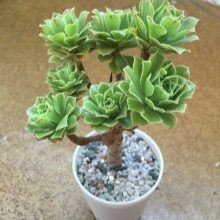
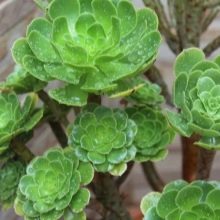
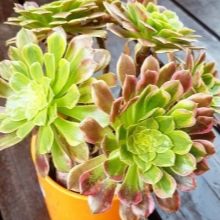
Popular types
At the moment, a huge number of varieties of aeonium grow in natural conditions, including pseudo plate-shaped, Tricolor and sedifolium. Besides, in the catalogs you can find such exotic names as Mardi Gras, Eonium Sanders, Leukoblefarum, Velor, as well as Sunburst, Lily Pad and Simsa. All existing types of desert rose have their own characteristics in the context of appearance, life form and care when grown indoors. At the same time, it is worth highlighting the most popular varieties of a unique flower among modern florists.
Balsamic
One of the main distinguishing features of this type of desert rose is its well-developed shoots, which outwardly look like the branches of a bush. Moreover, each of them is decorated with a rather dense rosette. The variety owes its name to a specific smell.
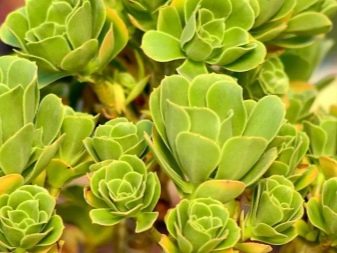
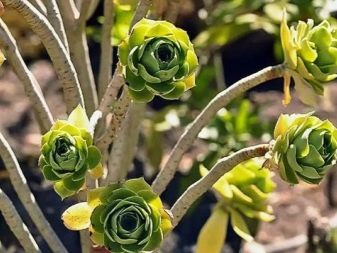
Noble
In this species, dense and rather large rosettes are located on a very short and almost invisible stem. The leaves themselves are slightly curved at the edges towards the center, which is why they resemble grooves. An adult plant can grow up to 0.5 meters in diameter. During the flowering period, the umbrella inflorescence, formed by yellow petals, is located on a high peduncle.
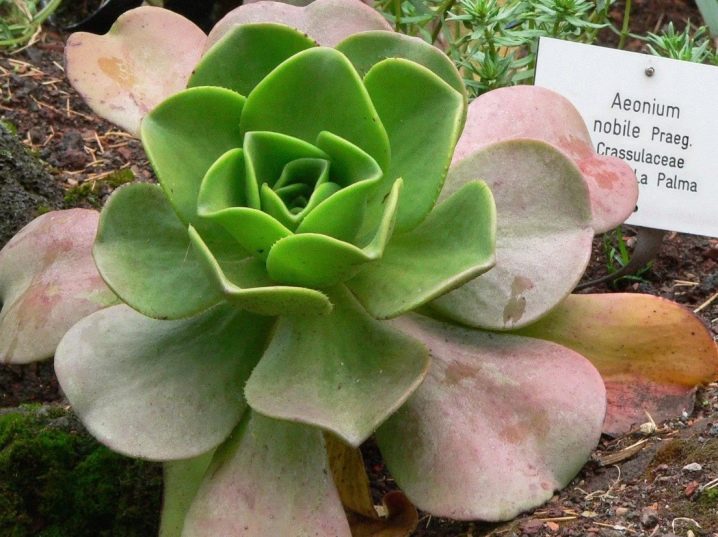
Burchard
Like all varieties of aeonium that exist today, this variety has its own flavor. And in this case we are talking about the unique color of the leaves, which is marsh green. In addition, it is worth highlighting the compact size of the sockets, which are about 10 cm.
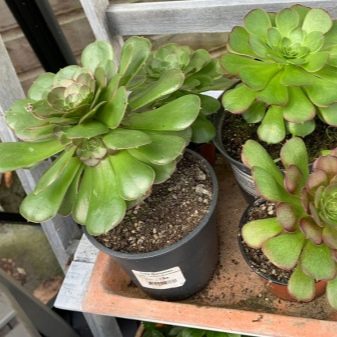
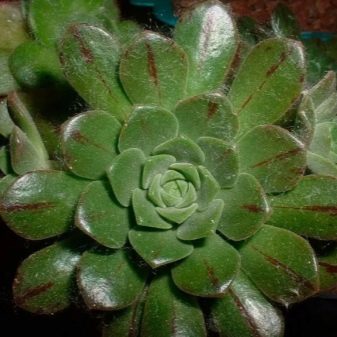
Virginia
The main distinguishing feature of this succulent is the absence of a stem. The plant forms a large number of tightly adjacent rosettes, formed by velvety, slightly wavy green leaf blades. This variety also has a light balsamic aroma. Due to the fact that the plant, as it were, covers the ground with its rosettes, it is also called the ground cover aeonium.
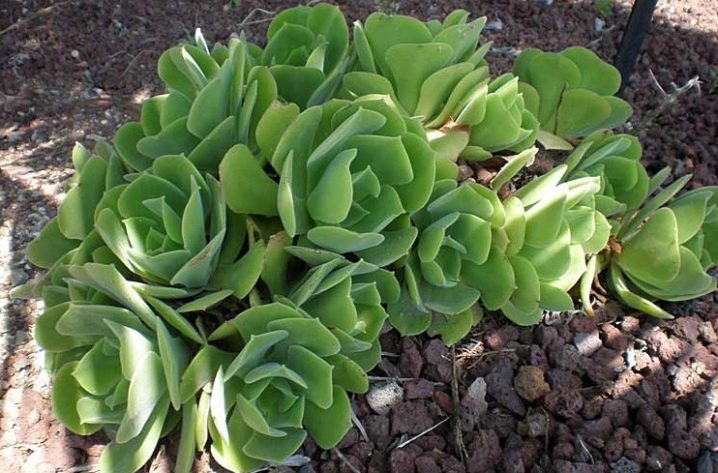
Wavy
One of the main attractions of this plant is its trunk, which has a silvery hue and at the same time is covered with burgundy ribs. All shoots are crowned with dark green, loose rosettes, formed by spatulate leaves, tapering towards the base and having a wavy edge. Inflorescences are pyramidal with yellow corollas.
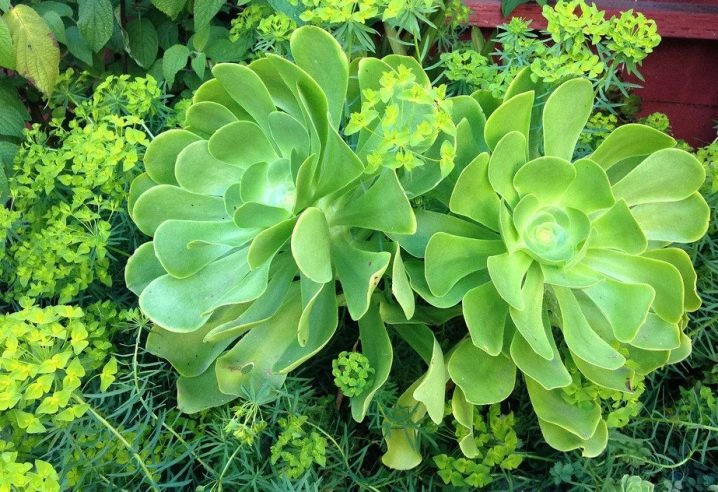
Decorative
It is a compact bush with multidirectional shoots. They are decorated with beautiful rosettes with a dense structure. And also the list of important features includes leaves that are unique in appearance. They are distinguished by pointed tips and a burgundy-green hue.
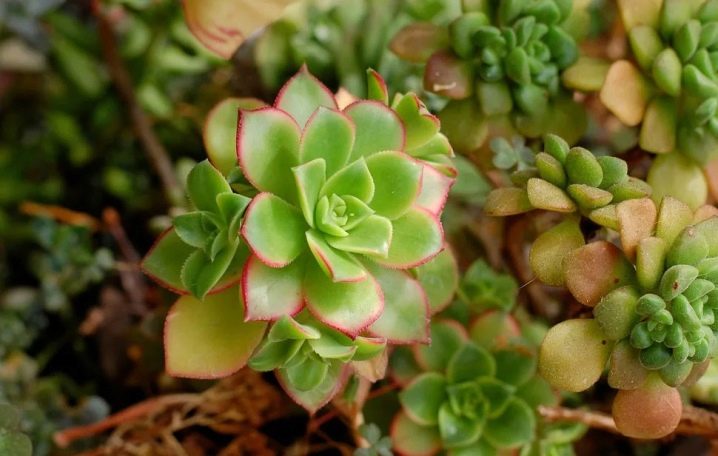
Home
This variety can be confidently characterized as a miniature tree with a dense, vertically oriented trunk (central stem). Shoots close to each other appear on it, bending in their upper part. They are decorated with large and loose rosettes. During flowering, a traditionally high peduncle develops, on which you can see 7 yellow flowers.

Tree-like
Based on the name of the variety, one can understand that one of its key features is the lignified stem. Side shoots radiate from it, the tops of which are crowned with dense rosettes. It is worth noting that breeders have bred several hybrid versions of the tree-like aeonium.
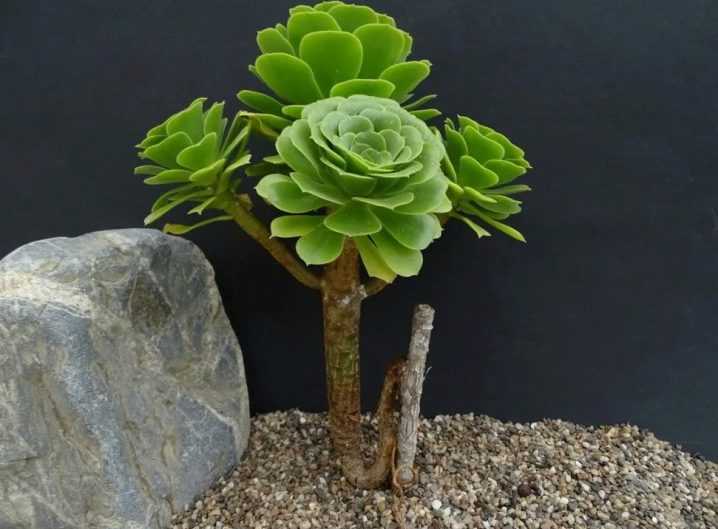
Golden
This type of aeonium has a branched stem and drooping shoots. Large rosettes formed from elongated diamond-shaped green leaf blades are a real decoration. And the variety owes its name to inflorescences of a characteristic golden color.
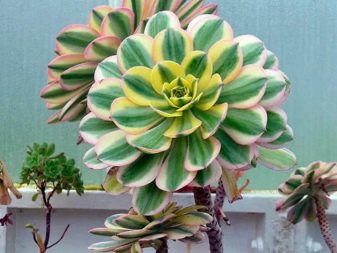

Canary
You can easily recognize this succulent by the densely planted rosettes located almost on the ground, which have a light green color. The fact is that the main distinguishing feature of the variety is its very short stems. Adult specimens can reach 50 cm in diameter. At the same time, during the flowering period, the peduncle is extended to a height of 80 cm.
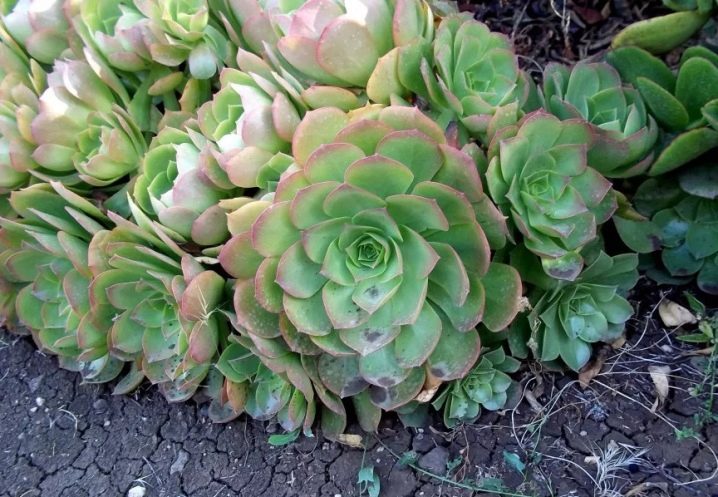
Kiwi
This variegated type of aeonium is one of the many varieties that have appeared thanks to the work of European breeders. The externally graceful shrub is distinguished by abundantly branching shoots and is a hybrid of the Haworth cultivar. In height, it most often does not grow more than 0.5 m, but at the same time in diameter it can easily surpass this indicator.
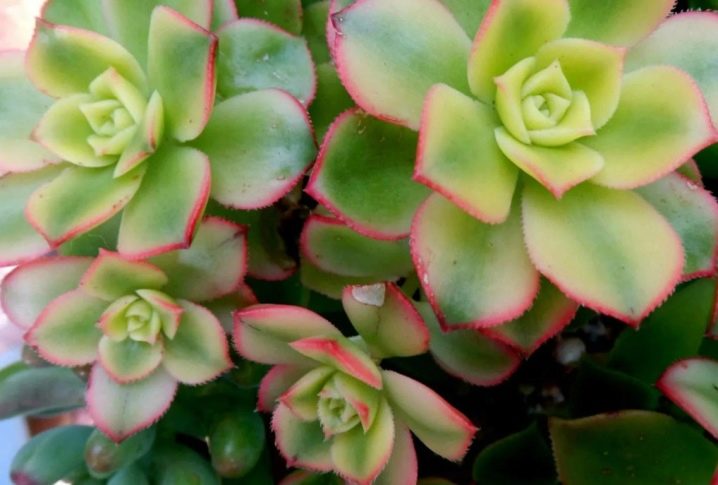
Lindley
This type of aeonium differs from its "counterparts" in that its stem grows woody at the base, while releasing a sufficient number of lateral shoots. At the top of each of them, as a result, a dense rosette is formed, consisting of green leaf blades covered with inconspicuous villi. During the flowering period, yellow corollas appear on the plant.
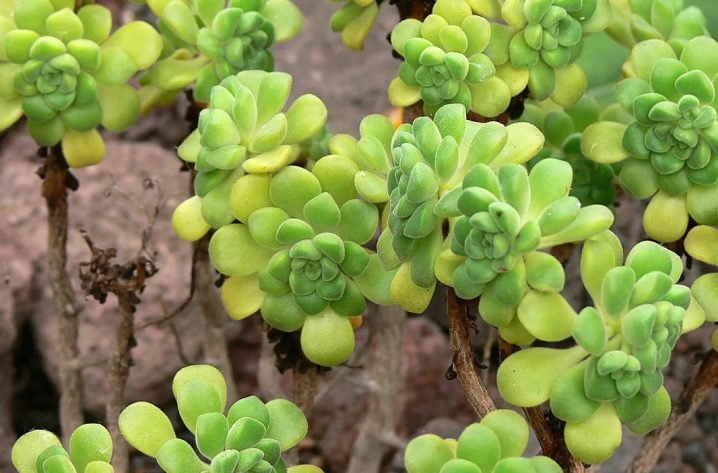
Layered
This variety is called longline by many growers and experts. Plants have short stems with flat and wide rosettes. They themselves are formed by many leaves growing in cascades (tiers). Narrow at the base, the plates widen noticeably towards the opposite edge.
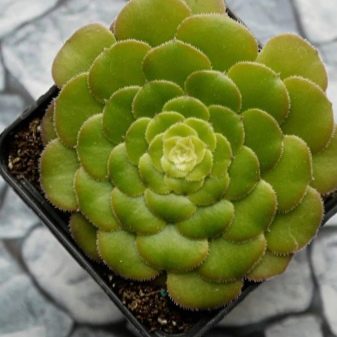

Schwarzkopf
In this case, we are talking about a hybrid variety of the tree-like aeonium. The key feature of this hybrid is its maroon coloration. It is thanks to her that the variety is also called Aeonium Black and Treelike Black.
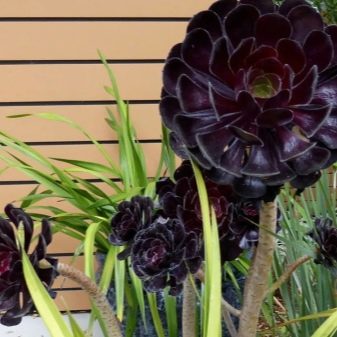
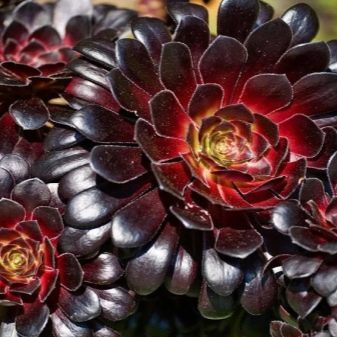
Haworth
This variety can rightfully be called one of the most aesthetic varieties. This aeonium owes its appearance primarily to rather large lanceolate leaves. Light green plates have a burgundy border. Thanks to this combination, in the end it seems that the leaves are silvery. Another distinctive feature is the short stems that are located directly under the rosettes.
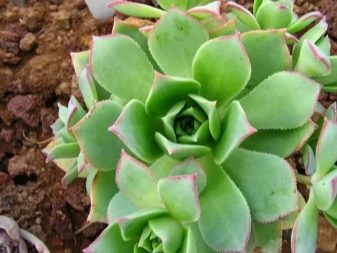

Landing
It is recommended to pay special attention to the correct choice of the pot. Wherein the stability of the container and the presence of drainage holes will be key criteria. And also experienced gardeners do not advise making a choice in favor of large pots. The best option would be a relatively low, but wide, therefore, stable model.
The material from which the pot is made does not play a decisive role in this case. Another important point is that aeonium, being a succulent, is not very demanding on the soil. For its full growth and development, even a clayey and rather poor substrate is quite suitable.
However, it is still recommended to use universal soil mixtures for shrubs. As already noted, the described plants, regardless of their varieties, are unpretentious. This is also true for taking care of the aeonium at home.
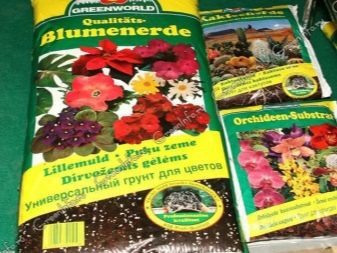
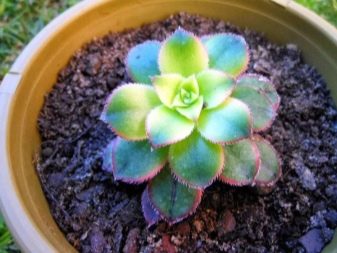
However, compliance with a number of general rules will be the key to full-fledged growth and development.
-
Illumination. This plant is predictably light-loving. So, in winter, it will be useful to place a phytolamp next to it as an additional source of light. At the same time, if the flower is located on the windowsill on the south side, then during the midday heat it will have to be shaded to eliminate the risk of burns.
-
Indoor temperature. It is important to consider that, despite the love of bright light and long daylight hours, the succulents in question can react negatively to heat. Optimal conditions are when the thermometer is between +20 and +25 degrees. In winter, a decrease in the indicator to +18 is allowed.
-
Watering must be moderate. It is also important to ensure that water does not get into the outlet during the procedure. Otherwise, it will be difficult to avoid the formation of rot, which can lead to the death of the plant. Moisten the soil when its top layer dries. By the way, the eonium itself will signal the florist about the need for watering by hanging the leaves.
-
Air humidity in the context of the activity of growth and development of the aeonium is not of decisive importance. This exotic flower is able to easily and quickly adapt to the dry atmosphere of the room. Taking into account this feature, the need for spraying is leveled. Moreover, experienced florists recommend trying to avoid them. To clean the leaf blades, wipe with a damp cloth.
-
Fertilization. If a high-quality substrate was used during planting, then in the first year it is possible, in general, not to feed the plant. As the soil mixture becomes depleted, it is recommended to apply fertilizers at intervals of 30 days. And in this case we are talking about a universal top dressing in liquid form, developed specifically for succulents. It is necessary to dilute in water and use such products, strictly following the instructions of the manufacturers.
-
Aeonium transplant. In the overwhelming majority of cases, young plants need to expand their capacity every 2 years. As the flower matures, the interval increases to 3-4 years.
-
Pruning. As a rule, the described plants do not need such procedures, and their care does not include pinching. It will be necessary to remove dried leaf plates and shoots that have released a peduncle.
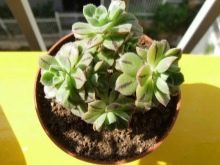


In addition to all of the above, it is worth paying attention to the so-called rest period. For the winter, the flower stops actively developing. During these months, it is necessary to reduce the already rather moderate watering of the plant to a minimum. At the same time, the introduction of any top dressing is stopped. Do not forget about the recommended decrease in the room temperature.
Reproduction
Initially, it is worth recalling that some of the succulents belonging to the described genus are monocarpic, that is, they die after they have faded. Plants continue to live in which lateral shoots have formed. Regardless of the species, aeonium can be propagated in three ways.
-
Seeds. This method involves scattering over the surface and slightly burying the seed into the ground. Next, the container with the sowing is periodically ventilated, and the soil is moistened. To activate seed germination, it is recommended to create greenhouse conditions at a temperature of +20 degrees.
-
By cuttings. In this case, you will need to separate the stem with a developed outlet. The cut is made 5 cm below this outlet, and its place is processed with crushed activated carbon. The stalk is planted in a separate container filled with a mixture of sand and leafy soil in a ratio of 2: 1. With proper care, rooting occurs in 2-3 weeks.
-
Leaflets. This option for the reproduction of aeoniums comes down to the correct preparation of several leaf plates. The technique involves the separation and drying of strong leaves for several hours. Then they must be laid out on the surface of the soil. At the same time, it is important to constantly maintain soil moisture by spraying. As a result, roots and small rosettes will begin to form. Once they are sufficiently strong, the young can be placed in a separate container.
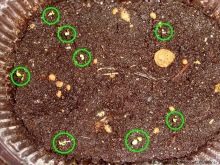
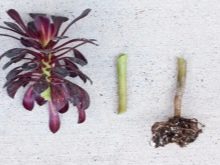
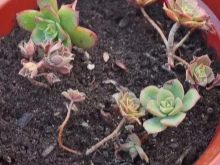
It is important to take into account that some of the aeoniums have rather thin leaf blades, and they are characterized by a small amount of pulp. That is why sometimes the succulent does not really have time to acquire roots and form a rosette, and the leaf is already drying out. Choosing this method for reproduction, you should take care of the availability of a sufficient amount of source material.
Diseases and pests
Despite the resistance to most ailments, flower growers have to face some problems, for example, often:
-
aeonium leaves dry and fall,
-
sockets rot
-
growth slows down.
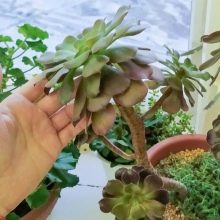
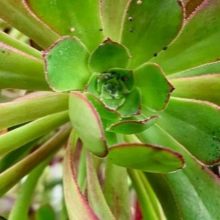
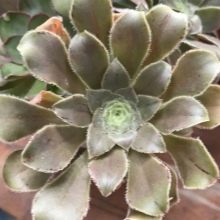
This happens, as a rule, due to violations of the rules of care. The appearance of brown and yellow spots can be a sign of a fungus. In such cases, immediate fungicide treatment will be required, and, if possible, soil renewal.
Most often, aeoniums are attacked by aphids and mealybugs. To combat aphids, it is necessary to treat the plant with a soapy solution, which is sprayed on the affected areas, as well as the lower surface of the leaves. If necessary, the procedure is repeated once a week. An early sign of a mealybug attack is a characteristic white pubescence. The easiest way to remove pests is with cotton pads or swabs dipped in alcohol, soapy water, or dishwashing liquid.
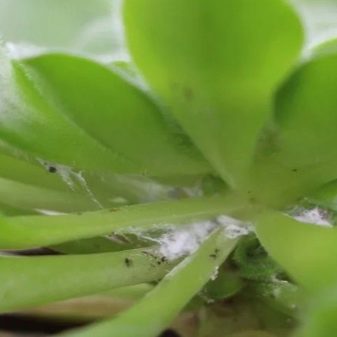
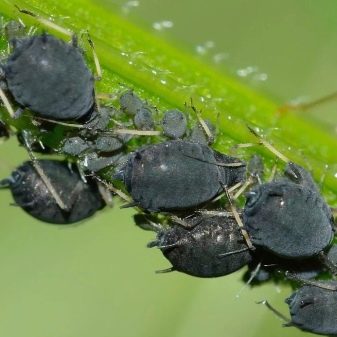













The comment was sent successfully.